
Rutgers-led study casts doubt on Himalayan rock weathering hypothesis.
A key theory that attributes the climate evolution of the earth to the breakdown of Himalayan rocks may not explain the cooling over the past 15 million years, according to a Rutgers-led study.
The study in the journal Nature Geoscience could shed more light on the causes of long-term climate change. It centers on the long-term cooling that occurred before the recent global warming tied to greenhouse gas emissions from humanity.
“The findings of our study, if substantiated, raise more questions than they answered,” said senior author Yair Rosenthal, a distinguished professor in the Department of Marine and Coastal Sciences in the School of Environmental and Biological Sciences at Rutgers University–New Brunswick. “If the cooling is not due to enhanced Himalayan rock weathering, then what processes have been overlooked?”
For decades, the leading hypothesis has been that the collision of the Indian and Asian continents and the uplifting of the Himalayas brought fresh rocks to the earth’s surface, making them more vulnerable to weathering that captured and stored carbon dioxide – a key greenhouse gas. But that hypothesis remains unconfirmed.
“If the cooling is not due to enhanced Himalayan rock weathering, then what processes have been overlooked?” — Yair Rosenthal
Lead author Weimin Si, a former Rutgers doctoral student now at Brown University, and Rosenthal challenge the hypothesis and examined deep-sea sediments rich in calcium carbonate.
Over millions of years, the weathering of rocks captured carbon dioxide and rivers carried it to the ocean as dissolved inorganic carbon, which is used by algae to build their calcium carbonate shells. When algae die, their skeletons fall on the seafloor and get buried, locking carbon from the atmosphere in deep-sea sediments.
If weathering increases, the accumulation of calcium carbonate in the deep sea should increase. But after studying dozens of deep-sea sediment cores through an international ocean drilling program, Si found that calcium carbonate in shells decreased significantly over 15 million years, which suggests that rock weathering may not be responsible for the long-term cooling.
Meanwhile, the scientists – surprisingly – also found that algae called coccolithophores adapted to the carbon dioxide decline over 15 million years by reducing their production of calcium carbonate. This reduction apparently was not taken into account in previous studies.
Many scientists believe that ocean acidification from high carbon dioxide levels will reduce the calcium carbonate in algae, especially in the near future. The data, however, suggest the opposite occurred over the 15 million years before the current global warming spell.
Rosenthal’s lab is now trying to answer these questions by studying the evolution of calcium and other elements in the ocean.
Reference: “Reduced continental weathering and marine calcification linked to late Neogene decline in atmospheric CO2” by Weimin Si and Yair Rosenthal, 23 September 2019, Nature Geoscience.
DOI: 10.1038/s41561-019-0450-3
3 Comments
I’ve thought for quite a while that as CO2 concentrations in the atmosphere increase, and subsequently CO2 dissolved in the ocean in the form of Carbonate and H+ increases as well, organisms that utilize these compounds would flourish, and instead of mass extinctions we’d see populations of some things reducing and others increasing as the environment changes.
It’s very interesting to see some evidence starting to pop up that supports this, and perhaps we’ll see that ecosystems changing to Earth’s changing atmospheric composition isn’t all bad.
There are still considerable concerns about organism that are largely stationary and lack the ability to migrate though, such as corals.
Another thought that comes into mind though, is that gases like CO2 dissolve better in lower temperatures, so perhaps more CO2 in the air leading to higher global temperatures may partially inhibit ocean acidification as the warmer temperatures would reduce the amount of CO2 that’s dissolving…
I’d be interested in seeing this tested in a lab. All it would need is a tank that can hold some Seawater and air, an intake valve to pump in more CO2, and some sensors to measure the CO2 content in air, air pressure, air and water temperatures, etc. This way one could measure amount of CO2 dissolved in the water as temperature and CO2 content goes up and pressure stays the same. The resulting graph would show to what extent higher temperature and higher atmopsheric CO2 content cancel each other out in terms of CO3 content in water.
yes, it’s all about the CO2 on the one hand and the dark matter on the other isn’t it?
otherwise our theories will – well, basically we need to start from just about scratch
Coccoliths are but a small part of the carbonate rock record which is dominated since the Cambrian by biomineralized carbonates other than algae but depend on them for food thus rapidly recycling algal biomass. The percentage ratio of oxygen to CO2 is 525 implying that carbon burial has increased over time…most of it as carbonate, some as “fossil fuel”. Regardless of the impact on climate over time, humans cannot “farm” coccoliths selectively to affect the current amount of CO2. Such studies with iron-fertilization failed…diatoms are silica, not carbonate.